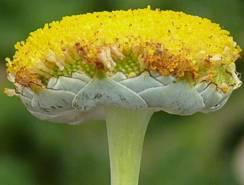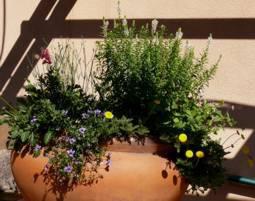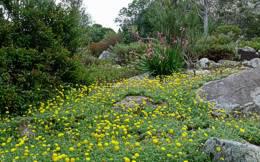Cotula sericea
Cotula sericea L.f.
Family: Asteraceae
Common names: silky cotula, buttons (Eng.); knoppies (Afr.)
Introduction

Cotula sericea is one of my all-time favourite herbaceous perennials. It is a sure winner in anyone's garden as it is prolific and rewarding to grow.
Description
Description
Cotula sericea is an evergreen, herbaceous perennial with sprawling stems, originating from a woody base. Plants can be 20-40 mm high, but usually have a low, spreading habit. The light green to grey-green leaves are twice or thrice divided into slender lobes. Both leaves and stems have fine hairs which give the plant its soft, silky texture.

Single, yellow button-like flower heads occur on long, naked flowering stems. These flower heads have minimal and very short yellow rays and are 10-15 mm in diameter. They are surrounded by three rows of large, heart-shaped bracts, each with three veins. The flowering stem (peduncle) swells when in fruit. Flowering occurs throughout the year, but plants have a spring and early summer profusion of flowers. Cotula sericea is a very variable species in the wild. Some forms are smaller and look straggly or "weedy", while others which are good garden specimens have large spectacular flower heads and a compact habit. They are particularly fast growing plants and although singular plants are short-lived, around 2 years, their sprawling stems root when they touch soil, perpetuating themselves and giving the impression of longevity.
Conservation Status
Status
Cotula sericea is not under threat.
Distribution and habitat
Distribution description
The silky cotula is found on rocky, coastal slopes in moist conditions from Mossel Bay to East London, at altitudes of 3-200 m.
Derivation of name and historical aspects
History
Cotula is a genus comprising approximately 80 species, including annuals and perennials. Typically they have pinnate leaves and single, yellow daisy-like flower heads without distinct rays. They are widespread in the southern hemisphere.
Cotula is probably derived from the Greek, kotule, which means cup, referring to the receptacle of the flower head. The specific epithet, sericea, means silky.
Cotula sericea and C. lineariloba have a history of being confused with each other due to some of the first descriptive writings using incorrect herbarium specimens. Distinct characteristics can tell them apart however:
Cotula sericea has naked flowering stems, a flower head surrounded by three rows of large, heart-shaped bracts with three veins, an inflorescence with minimal very short rays, a peduncle that swells when in fruit, and is known from localities from Mossel Bay to East London in coastal areas. C. lineariloba, on the other hand, has scattered thread-like bracts on the lower part of the flowering stem; narrow, elliptical bracts that have a broad, almost papery, margin with a single vein surrounding the inflorescence, no ray florets and no swelling of the peduncle when in fruit. The species occurs at high altitude localities in the Eastern Cape and Drakensberg.

Ecology
Ecology
Not much is known about the pollination of Cotula sericea. They are visited by common pollinators or perhaps pollen thieves like beetles and bees. Seeds are not widely dispersed from the parent plants. When seeds are ripe and disturbed, they crumble off the receptacle at the top of the peduncle and fall to the ground.
Uses
Use
Infusions of Cotula sericea are made into a wash for bad colds and rheumatism.
Horticulturally it is used in decorative garden displays, hanging basket displays, pots, herbaceous borders, rockeries, pond edges, seepage and damp areas.

Growing Cotula sericea
Grow
Cotula sericea is one of the most rewarding and easy-to-grow plants. It can be grown from seed, but it is mostly grown from cuttings because it roots so easily without the need of rooting hormones or any special media. Cuttings can be made from young, but not soft, vigorous shoots from parent plants. Often, if these shoots are touching the soil, they will already have produced roots. The cuttings can be planted directly into the garden soil where they will root and grow without requiring anything other than frequent watering until they are well established. For those gardeners wishing to grow them first in pots or trays, semi-hardwood tip- and stem-cuttings can be taken during the warmer months. Place cuttings in a well-drained, light potting mix in an area that receives good light, but not direct sunlight. Water frequently until cuttings have established themselves. The propagation tray can also be placed in a clear plastic bag to increase the humidity, although the cuttings must then be watched carefully for mould or rotting if the potting mix becomes too wet and warm. Once the cuttings are established they can be used in pots or garden beds. Cotula sericea tolerates quite a wide range of soils but seems to thrive best in well-drained, humus-rich soils. In sandier well-drained soils, the silky cotula will require extra feeding and regular watering for enhanced growth.
Place Cotula sericea in full sun, although it will also do well in lightly shaded areas. This cotula is quite water-wise even though it prefers regular watering. Placed in the correct area this plant can go without water for quite some time. Drooping tips will indicate the need for more water and help indicate if the established watering regime for your specific environment is sufficient.
Few if any pests have been noticed on this plant. Young stems in very moist or wet conditions may be prone to fungal infection, but this is quite an infrequent problem usually related to mechanical damage sustained by the plant. Cotula sericea will tolerate and even welcome regular fertilizing. Chemical fertilizers must be applied at soil level as they may burn the soft leaves, and they should be washed off if accidentally applied incorrectly.
In hanging baskets or pots, the plants will need replenishing quite often to remain attractive. Young stems can be cut and replanted to form new displays.

In the garden the silky cotula can be planted as a mass ground cover or in the foreground with companion plants such as Selago canescens to make fantastic colour and textural contrasts. Use strong, smooth-foliaged accent plants, such as Dietes grandiflora and Agapanthus species as companions to highlight the soft silky appearance of Cotula sericea foliage. Combining the silky cotula with Monopsis unidentata or Geranium incanum makes a bold colour combination and compliments the yellow buttons well in a mixed groundcover border or pot display.
References
- Hyam, R. & Pankhurst, R. 1995. Plants and their names, a concise dictionary. Oxford University Press.
- Jackson, W.P.U. 1990. Origins and meanings of South African plant genera. University of Cape Town Printing Department.
- Manning, J. 2001. Eastern Cape. South African Wild Flower Guide 11. The Botanical Society of South Africa, Cape Town.
- Smith, C.A. 1966. Common names of South African plants. Memoirs of the Botanical Survey of South Africa No. 35.
Credits
Monique McQuillan
Kirstenbosch National Botanical Garden
April 2010
Plant Attributes:
Plant Type: Ground Cover
SA Distribution:
Soil type: Sandy, Clay, Loam
Flowering season: Spring, Early Summer, Late Summer
PH: Acid
Flower colour: Yellow
Aspect: Full Sun, Morning Sun (Semi Shade), Afternoon Sun (Semi Shade)
Gardening skill: Easy
Special Features:
Horticultural zones









Rate this article
Article well written and informative
Rate this plant
Is this an interesting plant?
Login to add your Comment
Back to topNot registered yet? Click here to register.